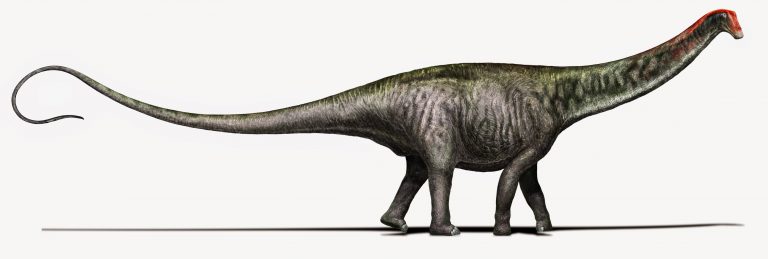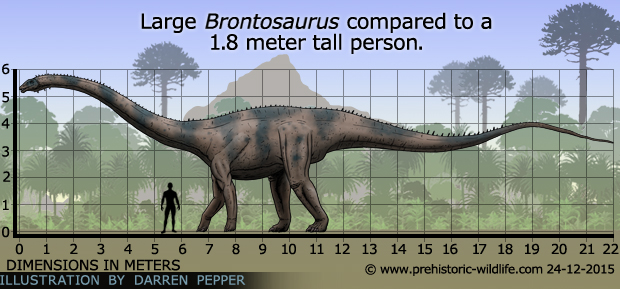Brontosaurus

Brontosaurus meaning “thunder lizard” is a genus of gigantic quadruped sauropod dinosaurs. Although the type species, B. excelsus, had long been considered a species of the closely related Apatosaurus, more recent research has proposed that Brontosaurus is a genus separate from Apatosaurus that contains three species: B. excelsus, B. yahnahpin, and B. parvus.

Brontosaurus had long, thin necks and small heads, adapted for a herbivorous lifestyle, as well as long, whip-like tails. They lived during the Late Jurassic epoch in the Morrison Formation of North America, going extinct by the end of the Jurassic. Adult individuals of Brontosaurus are estimated to weigh up to 15 tonnes (15 long tons; 17 short tons) and measure up to 22 metres (72 ft) long; this places Brontosaurus among the largest land animals along with other diplodocids.
As the archetypal sauropod, Brontosaurus is one of the best-known dinosaurs, and has been featured in film, advertising, and postal stamps, as well as many other types of media.

Brontosaurus was a large, long-necked quadrupedal animal with a long, whip-like tail, and forelimbs that were slightly shorter than their hindlimbs. The largest species, B. excelsus, weighed up to 15 tonnes (15 long tons; 17 short tons) and measured up to 22 m (72 ft) long from head to tail.
The skull of Brontosaurus has not been found, but was probably similar to the skull of the closely related Apatosaurus. Like those of other sauropods, the vertebrae of the neck were deeply bifurcated; that is, they carried paired spines, resulting in a wide and deep neck. The vertebral formula was: 15 cervicals, 10 dorsals, five sacrals, and 82 caudals. The caudal vertebra number was noted to vary, even within a species. The cervical vertebrae were stouter than other diplodocids, though not as stout as in mature specimens of Apatosaurus. The dorsal ribs are not fused or tightly attached to their vertebrae, instead being loosely articulated. Ten dorsal ribs are on either side of the body. The large neck was filled with an extensive system of weight-saving air sacs. Brontosaurus, like its close relative Apatosaurus, had tall spines on its vertebrae, which make up more than half the height of the individual bones. The shape of the tail was unusual for diplodocids, being comparatively slender, due to the vertebral spines rapidly decreasing in height the farther they are from the hips. Brontosaurus also had very long ribs compared to most other diplodocids, giving them unusually deep chests. As in other diplodocids, the last portion of the tail of Brontosaurus possessed a whip-like structure.
Classification
Brontosaurus is a member of the family Diplodocidae, a clade of gigantic sauropod dinosaurs. The family includes some of the longest and largest creatures ever to walk the earth, including Diplodocus, Supersaurus, and Barosaurus. Brontosaurus is also classified in the subfamily Apatosaurinae, which also includes Apatosaurus and one or more possible unnamed genera. Othniel Charles Marsh described Brontosaurus as being allied to Atlantosaurus, within the now defunct group Atlantosauridae. In 1878, Marsh raised his family to the rank of suborder, including Apatosaurus, Brontosaurus, Atlantosaurus, Morosaurus (=Camarasaurus), and Diplodocus. He classified this group within Sauropoda. In 1903, Elmer S. Riggs mentioned that the name Sauropoda would be a junior synonym of earlier names, and grouped Apatosaurus within Opisthocoelia. Most authors still use Sauropoda as the group name.

Originally named by its discoverer Othniel Charles Marsh in 1879, Brontosaurus had long been considered a junior synonym of Apatosaurus; its type species, Brontosaurus excelsus, was reclassified as A. excelsus in 1903. However, an extensive study published in 2015 by a joint British-Portuguese research team concluded that Brontosaurus was a valid genus of sauropod distinct from Apatosaurus. Nevertheless, not all paleontologists agree with this division. The same study classified two additional species that had once been considered Apatosaurus and Eobrontosaurus as Brontosaurus parvus and Brontosaurus yahnahpin respectively.
Species
- Brontosaurus excelsus, the type species of Brontosaurus, was first named by Marsh in 1879. Many specimens, including the holotype specimen YPM 1980, have been assigned to the species. They include FMNH P25112, the skeleton mounted at the Field Museum of Natural History, which has since been found to represent an unknown species of apatosaurine. Brontosaurus amplus, occasionally assigned to B. parvus, is a junior synonym of B. excelsus. B. excelsus therefore only includes its type specimen and the type specimen of B. amplus. The largest of these specimens is estimated to have weighed up to 15 tonnes and measured up to 22 m (72 ft) long from head to tail. Both known definitive B. excelsus fossils have been reported from Reed’s Quarry 10 of the Morrison Formation Brushy Basin member in Albany County, Wyoming, dated to the late Kimmeridgian age, about 152 million years ago.
- Brontosaurus parvus, first described as Elosaurus in 1902 by Peterson and Gilmore, was reassigned to Apatosaurus in 1994, and to Brontosaurus in 2015. Specimens assigned to this species include the holotype, CM 566 (a partial skeleton of a juvenile found in Sheep Creek Quarry 4 in Albany County, WY), BYU 1252-18531 (a nearly complete skeleton found in Utah and mounted at Brigham Young University), and the partial skeleton UW 15556 (which had once been accidentally mixed together with the holotype). It dates to the middle Kimmeridgian. Adult specimens are estimated to have weighed up to 14 tonnes and measured up to 22 m (72 ft) long from head to tail.
- Brontosaurus yahnahpin is the oldest species, known from a single site from the lower Morrison Formation, Bertha Quarry, in Albany County, Wyoming, dating to about 155 million years ago. It grew up to 21 metres (69 ft) long. The type species, E. yahnahpin, was described by James Filla and Patrick Redman in 1994 as a species of Apatosaurus (A. yahnahpin). The specific name is derived from Lakota mah-koo yah-nah-pin, “breast necklace”, a reference to the pairs of sternal ribs that resemble the hair pipes traditionally worn by the tribe. The holotype specimen is TATE-001, a relatively complete postcranial skeleton found in Wyoming, in the lower Morrison Formation. More fragmentary remains have also been referred to the species. A re-evaluation by Robert T. Bakker in 1998 found it to be more primitive, so Bakker coined the new generic name Eobrontosaurus, derived from Greek eos, “dawn”, and Brontosaurus.
Source: www.Wikipedia.org, www.NatGeo.com








